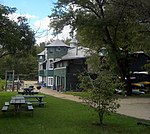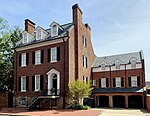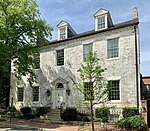Potomac Boat Club
1859 establishments in the United StatesBuildings and structures completed in 1908Clubhouses on the National Register of Historic Places in Washington, D.C.Georgetown (Washington, D.C.)Rowing club stubs ... and 3 more
Rowing clubs in the United StatesUnited States sports organization stubsWashington, D.C. Registered Historic Place stubs

The Potomac Boat Club is a rowing club on the Potomac River in Washington, DC. It was established in 1859, originally as the Potomac Barge Club. The club provides a rowing hub for around 300 senior members, ranging in ability from recreational rowers to professional athletes. The boat club hosts both private members, as well serving as a base for the Washington-Liberty High School crew team.
Excerpt from the Wikipedia article Potomac Boat Club (License: CC BY-SA 3.0, Authors, Images).Potomac Boat Club
Capital Crescent Trail, Washington
Geographical coordinates (GPS) Address Nearby Places Show on map
Geographical coordinates (GPS)
| Latitude | Longitude |
|---|---|
| N 38.904166666667 ° | E -77.070555555556 ° |
Address
Capital Crescent Trail
Capital Crescent Trail
20057 Washington
District of Columbia, United States
Open on Google Maps









